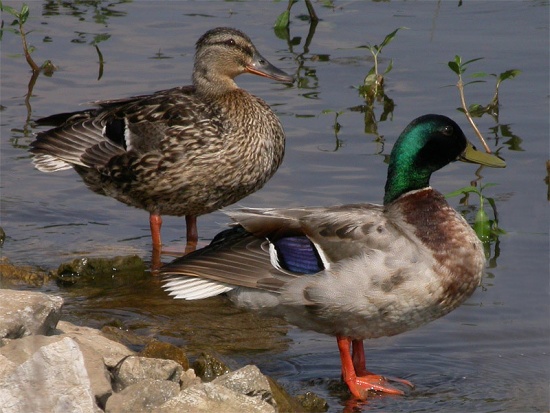(References started) |
(split of Mexican Duck) |
||
| Line 1: | Line 1: | ||
[[Image:Mallard.jpg|thumb|550px|right|Male at front, Female behind<br />Photo by {{user|mymantra|Paul Sansom}}]] | [[Image:Mallard.jpg|thumb|550px|right|Male at front, Female behind<br />Photo by {{user|mymantra|Paul Sansom}}]] | ||
| − | |||
;''[[:Category:Anas|Anas]] platyrhynchos'' | ;''[[:Category:Anas|Anas]] platyrhynchos'' | ||
==Identification== | ==Identification== | ||
| Line 13: | Line 12: | ||
Both have a white-edged blue speculum<br/> | Both have a white-edged blue speculum<br/> | ||
'''Eclipse male''' resembles female, but retains yellow bill. | '''Eclipse male''' resembles female, but retains yellow bill. | ||
| − | |||
| − | |||
Has been domesticated and many unusual Mallards are either escaped domestics or hybrids with such birds. | Has been domesticated and many unusual Mallards are either escaped domestics or hybrids with such birds. | ||
| − | |||
| − | |||
==Distribution== | ==Distribution== | ||
| − | The most abundant and widespread duck in the region breeding throughout [[Europe]] from [[Iceland]] and northern [[Scandinavia]] south to the Mediterranean, on some Mediterranean islands and throughout [[Turkey]]. Rare and local breeder in North-West [[Africa]] and [[Cyprus]]. | + | The most abundant and widespread duck in the region breeding throughout [[Europe]] from [[Iceland]] and northern [[Scandinavia]] south to the Mediterranean, on some Mediterranean islands and throughout [[Turkey]]. Rare and local breeder in North-West [[Africa]] and [[Cyprus]].<br /> |
| − | |||
Resident or partial migrant in [[Iceland]], the [[British Isles]] and Continental [[Europe]] from [[Spain]] east to the [[Baltic States]] and south to [[Greece]] and [[Turkey]]. Summer visitor to much of Scandinavia and [[Russia]]. | Resident or partial migrant in [[Iceland]], the [[British Isles]] and Continental [[Europe]] from [[Spain]] east to the [[Baltic States]] and south to [[Greece]] and [[Turkey]]. Summer visitor to much of Scandinavia and [[Russia]]. | ||
| − | + | '''Vagrant''' north to [[Svalbard]] and south to the [[Azores]] where has bred.<br /> | |
| − | + | Also in [[North America]], breeding in the [[USA]] and [[Canada]], wintering to Mexico and the Carribean. | |
| − | |||
| − | '''Vagrant''' north to [[Svalbard]] and south to the [[Azores]] where has bred. | ||
==Taxonomy== | ==Taxonomy== | ||
| + | Formerly considered conspecific with [[Mexican Duck]]. | ||
====Subspecies==== | ====Subspecies==== | ||
| − | There | + | There are2 subspecies<sup>[[#References|[1]]]</sup>:<br /> |
| − | |||
*''A. p. platyrhynchos'': | *''A. p. platyrhynchos'': | ||
:*Holarctic; winters to [[Mexico]], North [[Africa]], [[India]] and [[Borneo]] | :*Holarctic; winters to [[Mexico]], North [[Africa]], [[India]] and [[Borneo]] | ||
*''A. p. conboschas'': | *''A. p. conboschas'': | ||
:*Coastal south-western [[Greenland]] | :*Coastal south-western [[Greenland]] | ||
| − | |||
| − | |||
| − | |||
| − | |||
==Habitat== | ==Habitat== | ||
| Line 55: | Line 43: | ||
''[[Media:Anas platyrhynchos (song).mp3|Listen in an external program]]'' | ''[[Media:Anas platyrhynchos (song).mp3|Listen in an external program]]'' | ||
==References== | ==References== | ||
| − | #{{Ref- | + | #{{Ref-Clements6thAug18}} |
{{ref}} | {{ref}} | ||
==External Links== | ==External Links== | ||
Revision as of 10:54, 27 August 2018
- Anas platyrhynchos
Identification
Drake
- Green head separated from a brown breast by a white ring.
- Yellow bill.
- Curly central tail feathers.
Female
- Streaked brown body
- Brown bill with a variable amount of orange around the edge
Both have a white-edged blue speculum
Eclipse male resembles female, but retains yellow bill.
Has been domesticated and many unusual Mallards are either escaped domestics or hybrids with such birds.
Distribution
The most abundant and widespread duck in the region breeding throughout Europe from Iceland and northern Scandinavia south to the Mediterranean, on some Mediterranean islands and throughout Turkey. Rare and local breeder in North-West Africa and Cyprus.
Resident or partial migrant in Iceland, the British Isles and Continental Europe from Spain east to the Baltic States and south to Greece and Turkey. Summer visitor to much of Scandinavia and Russia.
Vagrant north to Svalbard and south to the Azores where has bred.
Also in North America, breeding in the USA and Canada, wintering to Mexico and the Carribean.
Taxonomy
Formerly considered conspecific with Mexican Duck.
Subspecies
There are2 subspecies[1]:
- A. p. platyrhynchos:
- A. p. conboschas:
- Coastal south-western Greenland
Habitat
Virtually any kind of freshwater from small ponds on farms and in town parks up to the largest reservoirs, and also swamps and marshes.
In winter especially, also on estuaries and sometimes on sheltered seas.
Behaviour
Diet
Diet includes insects, seed, roots, grain either whilst dabbling or on land.
Vocalisation
Male: Quiet kwack, nasally rheb.
Female: Loud traditional quack
<flashmp3>Anas platyrhynchos (song).mp3</flashmp3>
Listen in an external program
References
- Clements, J. F., T. S. Schulenberg, M. J. Iliff, D. Roberson, T. A. Fredericks, B. L. Sullivan, and C. L. Wood. 2018. The eBird/Clements checklist of birds of the world: v2018. Downloaded from http://www.birds.cornell.edu/clementschecklist/download/
Recommended Citation
- BirdForum Opus contributors. (2024) Mallard. In: BirdForum, the forum for wild birds and birding. Retrieved 27 April 2024 from https://www.birdforum.net/opus/Mallard
External Links




